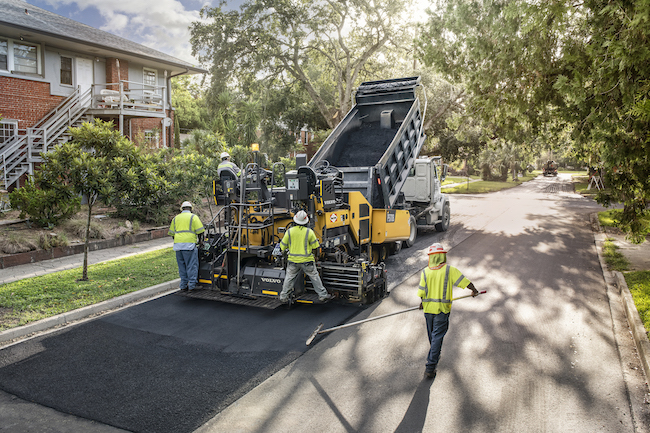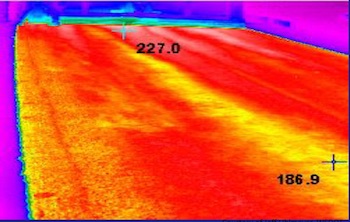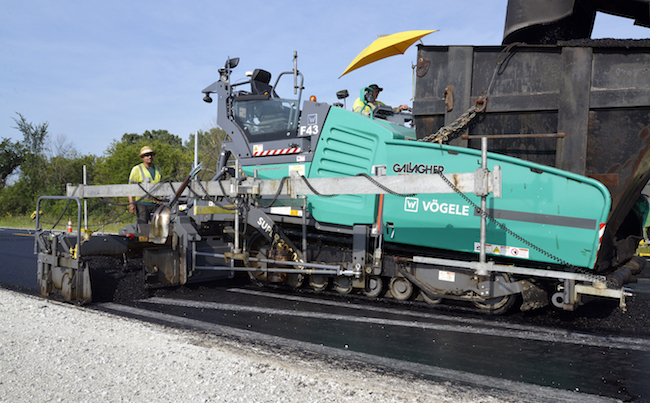
Innovative features extend paving season in colder markets, increase operator comfort and safety
By Megan Hoegler
Equipment RoadsIn Canada, the old saying goes, there are two seasons: winter and construction. While the cooler temperatures and frozen ground bring some projects to a halt, innovative new technology and upgrades to large-scale asphalt pavers are extending paving season in the Great White North.
“Canada tends to have a considerably shorter paving season,” Henry Polk, product manager of pavers for Bomag says. “The mix cools much faster during transport when it’s cold outside, which results in cooler mix going through the paver and showing up as a cold spot on the mat.”
To combat this, the company has released specialized paver models 652 and 662 with Remix technology. The technology reblends the mix using counter rotating augers, remixing 100 per cent of the asphalt and keeping it from cooling down too much. It doesn’t heat the mix, but it does result in a consistent temperature across the width of the mat, which reduces the appearance of cold spots.
In case any cold spots make it through, Bomag has integrated thermal imaging to detect the cold spot before it causes any serious problems.
“More and more places are instituting a thermal image spec on highway jobs,” Polk says. “An infrared camera records the thermal image of the job, then inspectors review the images and look for any large temperature differentiations in the mat. It’s been proven that cold spots are the origin of most asphalt failures, so identifying and repairing them early reduces repair costs later.”
Cold weather isn’t the only issue paver manufacturers are looking to tackle with a new generation of equipment.
Germany-based Vögele, a part of the Wirtgen Group, has focused on operator comfort in their latest models, among other features. Their models include heated seats and operator adjustments for optimal comfort inside the cab. The company is working on improving performance as well.
“We have seen increased interest in compaction screeds as opposed to classic vibratory screeds among Canadian contractors,” Jim Holland, vice-president for sales at Vögele says. These new tamper/vibratory screeds (TV) incorporate a tamper bar in addition to vibration for effective pre-compaction. The result is a higher mat density than a standard vibratory screed.
Over at Volvo Construction Equipment, customers are often unsure whether to go with a tracked or wheeled paver. Bill Laing, product manager of road products for Volvo Construction, says it depends on the application.
“Tracked pavers are good options in all paving applications, but they tend to be preferred over wheels on softer bases because of their traction and flotation,” Laing explains. “Wheeled pavers are preferred for mill and fill applications and where traction isn’t as much of a concern. They are also favoured in applications where the operator needs or wants to move the machine without putting it on a trailer. The wheeled paver is easier to move and travels faster, so it’s more flexible for transporting shorter distances.”
According to Holland, the most innovative changes among asphalt pavers have been in their control and drive systems. Hydraulic control systems and CAN (Control Area Network) designs have made it possible for microcontrollers and devices to communicate with each other independent of a host computer.
“These types of controls allow contractors to maintain consistency of the forces that holds the free-floating screed to-grade,” Holland says. Through precise management of the paver speed, material delivery, screed extend and retract and stopping and starting, we have been able to significantly improve the quality of pavement jobs.”
Vögele’s latest pavers, the three-metre tracked and wheeled Super 2000-3i and Super 2003-3i pavers, as well as the 2.4-metre tracked and wheeled Super 1700-3i and the Super 1703-3i, were introduced four years ago. Its Dash-3 paver models feature new and improved technology upgrades.
“We have developed a completely different mainframe,” Holland explains. “First, the profile of the machine is identical to the larger Super series pavers, which provide improved all-around visibility. The Tier 4 final engine utilizes a urea-based treatment system and the controls have also been updated to be more user-friendly.”
The updated controls allow contractors to maintain consistency, a precise speed, material delivery, screed extend and retract, all while, improving pavement quality.
This January, Volvo debuted two new pavers: the P5110B tracked paver and the P5170B wheeled paver. The mid-sized pavers were designed for both heavy and light highway tasks and built to be easy to maintain. Volvo’s engine speed technology was integrated into the design, resulting in a low rpm of 1200. These two new paver models will make their debut at CONEXPO in Las Vegas in March 2020.
Volvo has also been focusing on improving mat quality through automated paver functions and integrated technologies that help the paver to function more efficiently.
“Speed limiters, grade and slope control, auto vibration and material-flow sensors on the screed are all examples of technologies we use that help automate tasks that could cause mat quality problems,” Laing says. “And they make the paver more efficient for the operator.
Efficiency is a major focus for all manufacturers, who are building with the customers’ needs and wants in mind. When a customer invests in a paver, Polk says it’s important they get the most for their money. This means building a multipurpose machine.
“You need to build pavers that cover a wide range of applications,” Polk explains. “The customer wants to use the paver in multiple settings rather than owning several pavers each with limited applications.”
Keeping with the times, upgraded paver designs incorporate environmental and health benefits for workers. The U.S.-based National Institute for Occupational Safety and Health (NIOSH) classified asphalt fumes as hazardous chemicals in 1998 and recommended to limit exposure to just 15 minutes. These changes drove paver design changes during the 2000s.
“They don’t have anything to do with actually making pavement, but they do provide an opportunity to include improvements that benefit the performance of the paver and the working environment, which improves pavement quality,” Holland says.
Even with bells and whistles, the priority among customers is, and likely will remain, safety. Vögele points to its pavers’ enhanced operator safety features as major selling points for its products. The Vögele Dash 3 operator seat, for instance, positions the operator away from the augers, avoiding an annoyance when at the controls, while the machine’s tapered frame keeps the augers within sight. The cab also features a canopy to protect the operator from direct sunlight.
Whether it’s hovering uncomfortably close to freezing, or a hot, sticky summer day, the next generation of pavers are being designed to operate in any and all conditions. From keeping the operator as comfortable as possible while inside the cab to ensuring a smooth, cold spot-free mat, paving roads gets a little easier each year.
This article first appeared in the February 2020 edition of On-Site. You can read the entire issue here.







